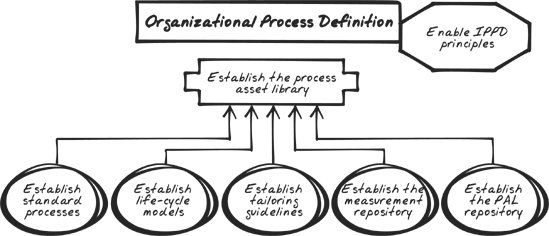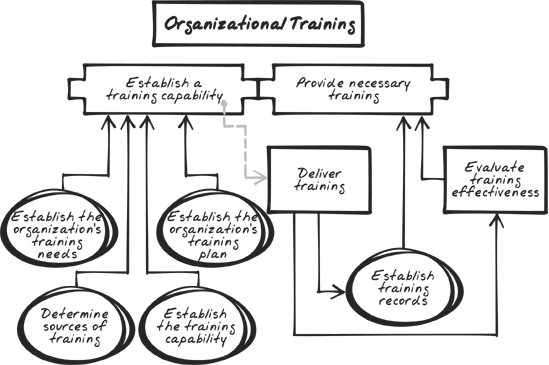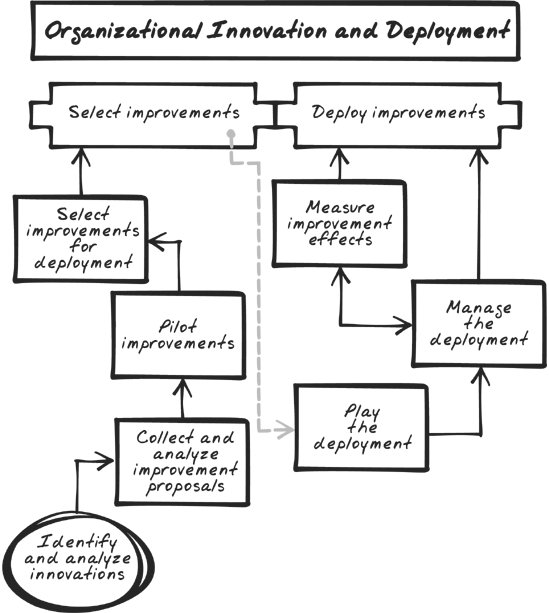Section 6.10. Process Management Process Areas
6.10. Process Management Process AreasThe following sections detail the Process Areas specific to process management. 6.10.1. Organizational Process FocusOrganizational Process Focus is an activity the organization implements once it has reached a certain level of maturity. It's reached that level when the organization is ready to institutionalize a set of common processes and practices across all its groups. With this step comes an organizational focus on process improvement. Previously (and here I'm talking specifically about maturity levels, but the basic idea holds true for implementing processes in general), process sets were managed at the project level, each project team working with a set of procedures, activities, and artifacts that met its needs. Here the focus shifts higher up to the executive level. With Organizational Process Focus, process-centric strategies and targets are put into place to support the analysis, planning, development, and execution of all process program components. Then these components are collected and managed by a chartered group within the organization. From this point on, the organization makes strategic decisions as to how its process program should be shaped as the needs of the organization evolve over time. 6.10.1.1. Two specific goalsCMMI defines two goals for Organizational Process Focus:
6.10.1.2. Core Organizational Process Focus actionsThe organization establishes strategic goals and objectives for its process program and coordinates the deployment of process improvement initiatives over time throughout the organization. Applies to Process Management:
Figure 6-18 illustrates the Organizational Process Focus PA. Figure 6-18. Organizational Process Focus provides a strategic approach for planning and managing process improvement activities. Here, the organization develops targets and objectives for process improvement activities, and then develops tactical plans for implementing the improvement activities across the organization. 6.10.2. Organizational Process DefinitionThis Process Area works in partnership with the Organizational Process Focus PA described previously. While OPF introduces centralized and coordinated management of the organization's process improvement activities, OPD centers on the management and deployment of the organization's process asset library, including those assets dealing with IPPD (when needed). The process library is a repository of standardized items available for use by the project teams as guidelines to work activity, product creation, and project management. This repository typically includes descriptions of processes and process elements, descriptions of life-cycle models, process tailoring guidelines, process-related documentation, measurement repositories, and other management tools and guidelines. The purpose of Organizational Process Definition is to provide a program that promotes a consistent and predictable mode of operations for management and development efforts across the organization. Further, this Process Area provides a resource for best practices, lessons learned, and metrics consolidated from groups across the organization. 6.10.2.1. Two specific goalsTwo goals are defined for Organizational Process Definition:
All of this is typically organized into a library, version controlled, and made available to members of the organization. 6.10.2.2. Core Organizational Process Focus actionsThe organization establishes a central repository of process assets and IPPD assets (as needed) and makes this repository available for organization-wide use. Applies to Process Management:
Figure 6-19 illustrates the Organizational Process Definition PA. Figure 6-19. Organizational Process Definition is centered on establishing a commonly used set of process assets. Housed in a Process Asset Library are such typical components as process descriptions, life-cycle methodologies, tailoring guidelines, and the measurement repository. Another activity is to enable IPPD principles when needed in the organization. 6.10.3. Organizational Process PerformanceOrganizational Process Performance is a Process Area related to Quantitative Project Management. As noted earlier in this chapter, under "Project Management Process Areas," the goal of QPM is to provide a set of guidelines and activities that project management can use to quantitatively measure project activity and performance over time and against a set of predefined benchmarks. That same concept applies here, but with a slightly different focus. Organizational Process Performance is managed and used (by designated team members) to regularly track the efficiency and effectiveness of the processes used within projects. Processes are observed and then measured to produce a base set of metrics used to predict how the processes will influence project performance. Process performance baselines, models, and trends can then be charted. When implemented on future projects, management can use these metrics as part of the planning process, and as an aid to predicting schedules, budgets, and resource needs. Further observations can also be used as a source for process improvement data. 6.10.3.1. One specific goalCMMI defines one goal for Organizational Process Performance:
6.10.3.2. Core Organizational Process Performance actionsThe organization quantitatively measures a selected set of process elements and then uses these measures as predictors of performance and efficiencies for future projects. Applies to Process Management:
Figure 6-20 illustrates the Organizational Process Performance PA. Figure 6-20. Organizational Process Performance is another high-maturity Process Area. Here, the organization establishes baselines and models of process performance based on detailed measures of past process performance. The baselines and models can then be used to predict future project performance. 6.10.4. Organizational TrainingThis Process Area is designed to support the institutionalization of a comprehensive process program throughout the organization. The success of any such program is contingent upon the knowledge your people have of it and their ability to use it. In light of this, training is a key way to ensure that your people are familiar with your program and know how to use it. The Organizational Training Process Area promotes a series of practices. These include defining what courses are needed to support your program, designing and publishing course material, accounting for the availability of training facilities, and arranging for competent instructors to conduct the classes. This PA also provides a framework for establishing training recommendations for the members of the organization, identifying the training needs of employees, arranging for class participation, and establishing methods for keeping and tracking training records. 6.10.4.1. Two specific goalsThere are two goals established for Organizational Training:
6.10.4.2. Core Organizational Training actionsThe organization establishes a training program to educate its people on the use of its process set, and then implements appropriate activities to deliver the training. Applies to Process Management:
Figure 6-21 illustrates the Organizational Training PA. Figure 6-21. Organizational Training deals with helping the organization establish a training capability to address ongoing training needs. This includes developing training objectives, devising training responsibilities, and creating a tactical training plan. Also included are activities for delivering training, for maintaining training records, and for assessing overall training effectiveness. 6.10.5. Organizational Innovation and DeploymentThe purpose of Organizational Innovation and Deployment is to select and deploy incremental and innovative process program improvements that measurably improve the organization's management processes and technologies. The improvements support the organization's quality and process-performance objectives as derived from the organization's business objectives. This Process Area represents the culmination of process management in CMMI. 6.10.5.1. Two specific goalsTwo goals are defined for this Process Area:
6.10.5.2. Core Organizational Innovation and Deployment actionsThe organization strategically develops enhancements to its process program and then deploys these enhancements in a coordinated manner. Applies to Process Management:
Figure 6-22 illustrates the Organizational Innovation and Deployment PA. Figure 6-22. Organizational Innovation and Deployment provides for practices that help an organization roll out process improvements in a planned and coordinated manner. Activities in this area include selecting improvements to implement, piloting improvements to ascertain effectiveness, rolling improvement out across the organization, and measuring the effectiveness of the new and enhanced processes.
|
EAN: 2147483647
Pages: 116